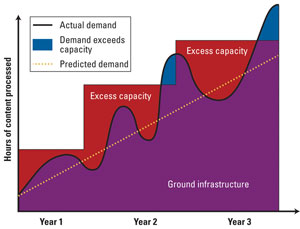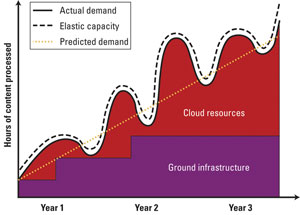Cloud video processing
Video processing requirements are becoming more complex as media consumption habits change and the number of consumer devices capable of displaying video increases, requiring support for an expanding number of file formats. Multiscreen viewing of both live and on-demand content increasingly challenges media companies to assess how much on-site infrastructure to procure to satisfy spikes in demand without overinvesting.
Ensuring a high-quality, reliable consumer viewing experience across multiple screens requires the processing of massive amounts of video — as seen in the Olympics last summer when data delivery peaked at 2.8PB of content, featuring a peak rate of 700Gb/s, when Bradley Wiggins won the gold medal in men’s cycling.

Figure 1. Video processing demand
The chart shows an example of predicted demand for video processing capacity compared to actual demand, where the red steps represent capacity purchases over time. (See Figure 1.) An obvious concern is where demand exceeds what fixed infrastructure can support. However, the opposite situation can prove even more costly over time, where demand runs lower than capacity, resulting in investments that go unused.
Media companies that don’t have enough video processing infrastructure to meet variable demand may find it difficult to keep up with customer expectations for top-quality service. Production houses that buy more infrastructure than they need will incur the unnecessary costs of maintaining resources that sit idle. Either way, they lose money.
The cloud offers a rational and cost-effective solution to the problem of variable demand by offering the ability to instantly scale up video processing capacity to accommodate high-traffic events, and then back down again as traffic wanes, while avoiding additional hardware investments that aren’t consistently utilized. Just like paying for a utility such as water or electricity, media companies can replace additional capital investments with more predictable operating costs that rise and fall depending upon the amount of cloud resources they actually use. Cloud computing can help organizations handle variable video processing demand with great flexibility and agility, enabling them to improve customer service while at the same time reducing capital costs.
Cloud computing also presents exciting opportunities for media and entertainment companies that want to minimize the risk of launching new initiatives. For example, a broadcaster can quickly introduce a new program or channel using cloud transcoding and evaluate its success without investing in additional infrastructure. Once the new inititave is proven successful, investments in on-premise infrastructure can be made confidently to balance long-term economics.
The professional video industry's #1 source for news, trends and product and tech information. Sign up below.
Likewise, the cloud offers the opportunity to take one-time projects without long-term investment. For example, many media companies have an extensive catalog of content, but supporting the infrastructure required to convert a video library into new distribution formats can be costly and inefficient. Using cloud resources, broadcasters can enhance offerings and extract unrealized revenue to make archived video footage available to customers on demand.
Overcoming challenges
While the cloud has been a hot topic, until recently, several obstacles have put cloud transcoding out of reach for many companies, particularly those that process high volumes of professional-quality video. The good news is that these hurdles are quickly disappearing.
First, until recently, the cost of processing video in the cloud has been prohibitive, especially for high-volume production houses. Yet as more providers such as Google, HP, Rackspace and Amazon Web Services (AWS) enter the market, competition and increasing supply are driving down the price of cloud resources. As these providers continue to grow, users will benefit from economies of scale, which will make large-scale video processing even more affordable in the cloud.
Second, the transfer of data is a tremendous challenge for organizations moving large, mezzanine-quality video files. Yet this issue is being addressed by accelerated data delivery systems. For example, Aspera and Signiant have designed highly efficient transport technologies that move data at maximum speed, regardless of file size, transfer distance or network conditions. In addition, Amazon recently introduced the Direct Connect service, which makes it nearly as fast to move data between an on-premise facility and AWS as it is to move data across a high-speed local network. Innovations such as these help mitigate data transfer bottlenecks.
Third, concerns about data center outages and system failures have prevented many media companies from moving assets off-site. However, this issue is ameliorated as the cloud matures and vendors build more enterprise-grade reliability. For example, most established cloud vendors have built redundancy measures into their services, and replicate data and resources across multiple geographic zones for enhanced durability in case of outages.
Fourth, media executives are understandably concerned about security. In many cases, their video assets fuel a multibillion-dollar business, so they’re leery about letting them be processed off-site. However, as the cloud becomes more widely adopted, media companies are becoming
increasingly comfortable with the concept of cloud-based video processing.
Large-scale data centers are capable of providing greater security than many individual media companies could afford on their own. Most established data centers support high levels of encryption and undergo industry-standard security audits. Amazon’s cloud, in particular, has received the highest possible maturity rating from the Motion Picture Association of America (MPAA) for securely storing, processing and delivering protected media and content.
Foundational elements
There are key considerations that must be prioritized to ensure an economical, effective balance of ground and cloud transcoding resources:
- Feature parity: Select a platform that can exactly replicate the profiles, capabilities, and formats used on premise so that video outputs are identical regardless of where they are processed.
- Unified management: Make sure cloud-based and on-premise video platforms can be administered from a single interface and API so both sets of resources are managed seamlessly.
- Secure environment: Avoid multitenant environments and publically exposed networks.
- Reliable implementation: Ensure the cloud system spans multiple regions and availability zones for redundancy.
- Data transfer: Select cloud-based data centers that are located near on-premise data centers and leverage accelerated data transfer services.
- Experience: Make sure the vendor is equipped to meet FCC regulations and other standards, and quickly supports new ones.
- Recommendation: A hybrid approach
How can media, entertainment and broadcast companies best leverage video processing in the cloud? Low-volume broadcast companies may want to move all transcoding functionality to the cloud so they can scale resources up and down as necessary. For companies that consistently process vast amounts of video, the economics of a cloud-only system are still challenging. For those companies, a hybrid workflow makes the most economic sense.

Figure 2. General trend lines of an economically optimized video processing system at the high end of the broadcast industry, over time
A hybrid workflow is achieved by maintaining just enough on-premise infrastructure to fulfill day-to-day transcoding requirements, while leveraging cloud services for the elasticity to keep pace with demand. (See Figure 2.) This ground-to-cloud approach has the potential to save organizations significant capital expenditures. Augmenting in-house transcoding capacity with cloud resources can reduce video processing costs by at least 50 percent, and by as much as 80 percent, according to a report by the multinational technology consulting firm Accenture.
Being flexible about leveraging both on-premise and cloud resources allows companies to cost-effectively balance transcoding resources, while optimizing capital investments already made.
As cloud computing vendors continue to tackle the issues of cost, data transfer and security, interest in cloud-based transcoding is sure to grow among media and entertainment companies in the near future. By taking a hybrid approach, media companies can fully reap the benefits the cloud can offer.
—Dustin Encelewski is director of product marketing, Elemental Technologies.
